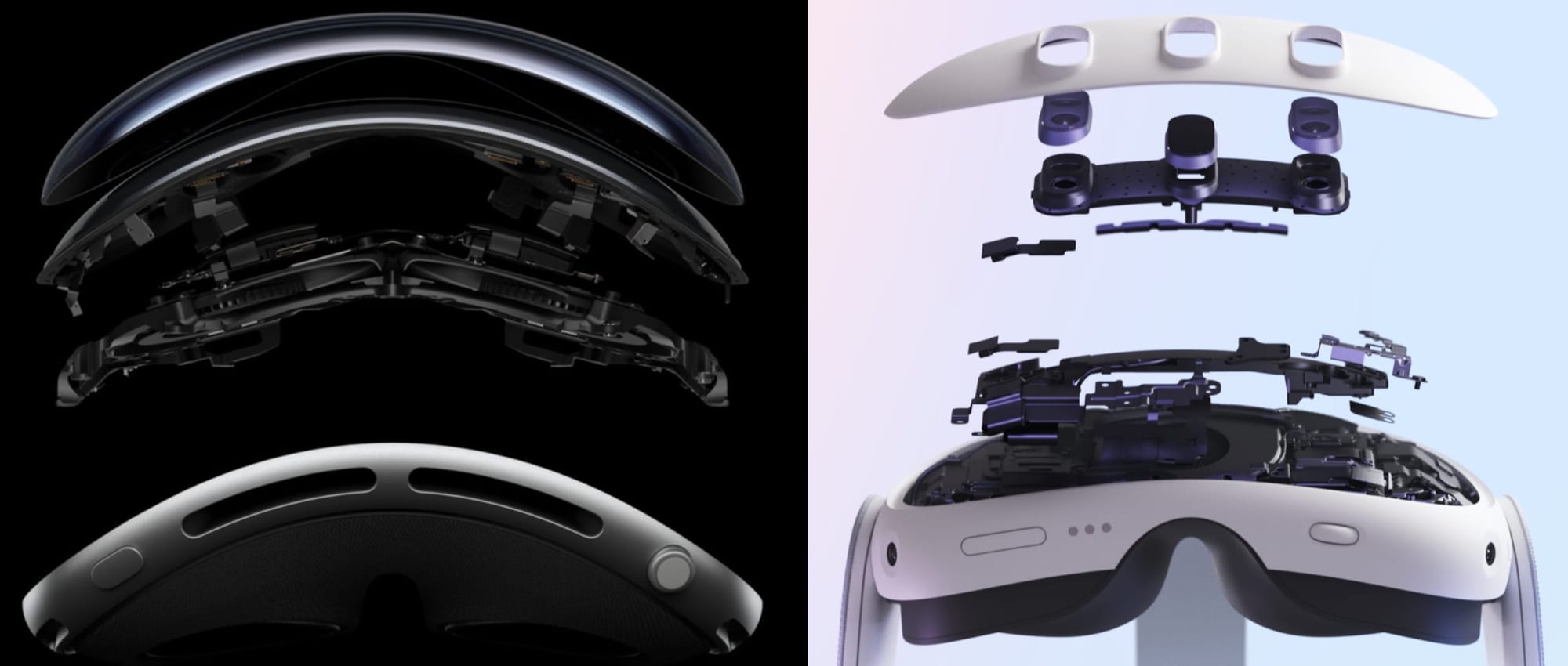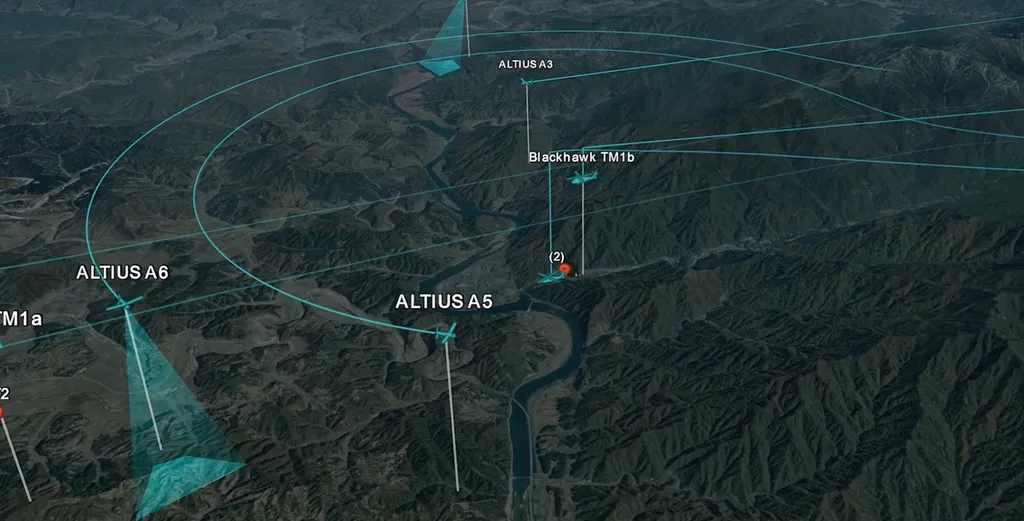I’m tired of corporations contributing to the misunderstanding of virtual reality as they deploy branding tactics in place of genuine education.
Apple and Meta employ marketing departments and vast legal teams attempting to imbue the vision of their executive leadership on the public. Terms like “mixed reality” and “spatial computing” and “augmented reality” and the “metaverse” are hoisted like banners above their efforts, obfuscating what’s actually going on.

These two western tech giants ship the same thing as the future of personal computing — a wide field of view head-mounted display priced at two ends of the consumer spectrum. At Meta Connect this year, I talked with Kent Bye for his oral history project, and a few months earlier on the show floor at AWE I did the same with Anduril founder Palmer Luckey. I put forth the view to both that consumer headsets are fundamentally the same technology which drone operators use to end lives.
War
We call those particular head-mounted displays First Person Viewers, but the biggest difference from consumer VR headsets is that they are single-purpose devices rather than general purpose computers. Instead of multitasking computing power, they feature long-range antennas designed to transport the operator into the body of a fast-moving flying machine packed with explosives.
So what happens when you hook up an antenna to a general-purpose computer like the $300 Quest 3S? Does it offer any benefits over the dedicated FPV headset? Anduril’s page for command and control already outlines the general idea while depicting the older Quest 2.
A fleet of aircraft or satellites could map the landscape from far above and draw the surrounding terrain with all the people inside it. Such a tool, laying out the physical world in front of you like the chess pieces on a game board, could look much like the playful app Wooorld, one of the best mixed reality experiences, whose users simply revisit their childhood home or play geography quizzes with friends.
Floating above that live 3D map will be a 1080p virtual display, bigger than a 70-inch television mounted to a wall, showing the live view of an explosive-packed low-altitude remote-controlled drone that’s closing in on-the-ground targets.
Meta’s recent updates to Quest headsets, which bring multitasking to Horizon OS, could offer side panels with relevant information or even views to backup drones. What’s more effective than commanding a single explosive-packed drone? As soon as it explodes, the pilot’s eyes turn to the next one. Each aircraft obliterates itself like a World War II kamikaze, without the loss of the pilot, as the next death package is already ready for a final run.
AI
Of course, automation is here as well to make these decisions for us instead of the pilots themselves, giving us A Taste Of Armageddon from Star Trek in 1967. Are you ready to walk into the incinerator because a computer decided you were in the blast radius of a virtual bomb that didn’t need to be dropped? As we hand over human decision-making to pattern-finding machines one layer at a time, at some point we need to ask where AI decisions end and human decisions begin, and the interplay between them. I’m asking that question here, and I hope in reading this I can convince some people to interrogate that question too.
I begin here with the limits of human decisions, and death from above, because I want you to understand the growing impact on actual human lives today of virtual reality accessed from head-mounted displays. If you understand that you go to a place in any wide field of view headset which blocks out the physical world, and that place is a shortcut to any other place, then you start to see the impact here. You can also begin to forget the branding exercises of corporations attempting to bend research and science fiction terminology to match corporate goals.
Transportation
Tim Cook saw the potential of VR when he shipped a headset to early adopters while cancelling a car project. Mark Zuckerberg saw that potential when he visited Valve’s room at Oculus in 2014 and then went to Stanford, essentially following the same route I pursued myself interviewing Luckey and then Stanford's lead VR researcher in 2012 for my first in-depth article on the effort.

There is a direct connection between the 20th century’s gas guzzling cars and mass media televisions to the climate today washing away homes with each new hurricane as parents are stricken with fear that their children will be snatched off the street in front of their homes. If you take a view that realizes our current attachment to 20th century’s technologies is likely to die with boomers who made those the shaping forces of modern life, your eyes can clear a bit to both the near-term and long-term potential.
In the 21st century, we should be able to rocket across the United States in a self-driving car at 100 miles per hour, reclined in the back seat wearing a wide field of view head-mounted display the whole trip. Immersed in your headset, you could use your hands in the open air to draw back a slingshot and fire projectiles which arc through the sky at a dragon making passes at your vehicle. Enjoying VR in such a tight climate-controlled environment, with air conditioning and heat ready to blow on you, would deliver a sense of immersion to your skin that’s only been felt at future-facing conferences like SIGGRAPH. Yes, you could actually feel the icy touch of the wind on a cold moon or the blast of heat from dragon fire in the tiny enclosed space of an autocar.
Is that too far a future for you? A closer future to imagine is being seated in a Waymo car driving itself around downtown Los Angeles while a passenger wears a VR headset. Like its Street View and Google Earth products, Alphabet can take historic photos and maps of the city and reskin your view of the entire city so that it looks like the 1920s. Yes, VR headsets are time machines too.
“Defy distance” was the rallying cry at Oculus for some time, and the phrase brilliantly captures the imaginations of developers looking to create art and education that enlightens, entertains, or inspires us by collapsing space while toying with scale and time.
“A lot of people have ideas on how to make transportation better. Alright, self-driving cars, hyperloops, and don’t get me wrong I love all of that stuff, but it’s 2017 and the biggest trend in transportation is that its a lot easier to move bits around than atoms,” Zuckerberg said early in this journey.
Sex
VR is also used in large numbers by adults to partake in a more impactful kind of sexual interaction than traditional “sexting”. Any partner you want can seem to perform any act you desire with bluetooth-connected accessories remotely connecting the actions of these individuals in real-time. It’s already a more common aspect of modern sex than most people realize, and you can look at the economics of OnlyFans ($6.3 billion in gross revenues for 2024) for an indication of its reach. With the Internet moving bits, and a head-mounted display delivering embodiment, VR enables sex which neither transmits disease through contact nor results in unwanted pregnancy.
What is risked by handing over the most fundamental of human bonding and evolution to the Internet as intermediary? Many people already lament leaving their first impressions to swipes on photos, but those connections are often still geo-restricted because many people value what they learn from the smell, taste, and warmth of another’s skin before committing long-term to significant time together. VR is changing this particular game, so to speak, and we’ll discover how relationships and people change as we go.
The key thing to convey here is that this transformation is already well underway.
Games
If VR is reshaping war and sex while simultaneously collapsing distance such that transportation is poised for massive change too, why are so many companies and individuals focusing so much of their time and money on games?
Games are fun, of course, but I propose that games are about the only part of this transformation that doesn't challenge most people's core understanding of the world. Games are the lowest stakes parts of our lives to most people, and for that reason discussing them doesn't cause overwhelming future shock.
Still, in embodied VR, "games" aren't games as we've come to think of them. When you actually feel like you've stepped into the shoes of Batman, Iron Man, or anybody else, you're not "playing as" the character. You are the character.
Now transfer embodiment to the public playgrounds seen inside Roblox, VRChat, Rec Room and Horizon Worlds. While these places are predominantly inhabited by children, the general public and parents must reconcile the idea that embodiment changes the impact of these spaces and the interactions within.
These free-to-play spaces are also inhabited by a small number of adults role-playing as children. While a mentally ill person can often be spotted on the street from a block away in a physical space, in VR with the wrong safety setting that same person could whisper in the ear of a child out of view of any parents who misunderstand what’s going on here. While many parents understand the safety settings these platforms have developed to protect children, some do not.
Profit
I have spent nearly ten years at this news outlet amplifying the work of genuine artists making difficult decisions about how to navigate this technology. The recurring theme of my work, however, is that creators face hard limits to their impact because they are forced to route their projects through tollways and policies Apple, Valve, Google and Meta have set up in front of them.
From these tolls come services meant to assist developers and provide safety to users. These tolls, however, also shape behavior in secondary ways.
For the better part of this year, developers have expressed concern that Meta has prioritized promoting its free-to-play Horizon Worlds content in front of developers who have released groundbreaking paid projects in support of Quest. The sudden shift seems to be upending teams and risking livelihoods as the switch deprives them of eyeballs and wallets they learned to expect would arrive with the launch of each new Meta headset.
While we cover this on an ongoing basis, I encourage you to become a member of UploadVR as we continue to shine a light on those artists and their work. We're not changing our focus here anytime soon, but I needed the space on this particular platform to state at least once, for the history books and for you, that a $300 VR headset is not a new kind of Nintendo Switch. It is the delivery mechanism for a paradigm shift in human behavior like the one which followed the printing press.
So if you hand off that VR headset to your child instead of interrogating its benefits and risks for yourself, you’re not preparing yourself, your family or your friends for the change that’s already well underway in places many people don't like to talk about in public.
And yes, maybe we should all go touch some grass too.




























